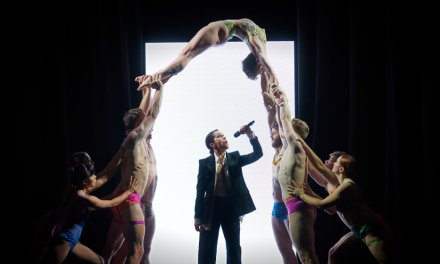Stop reading this. Wait, that’s paradoxical. Don’t start reading it at all. Go see The Shape of Water, then come back and read this.
The film is superb. It deserves every bit of praise it’s received, it contains one of the best lead performances I’ve seen, up there with F Murray Abraham in Amadeus, and it all looks and sounds gorgeous. It’s the best film of Guillermo Del Toro’s varied career. That’s high praise when you remember that The Devil’s Backbone and Blade 2 exist. Yes. It’s even better than Blade 2.
Guillermo Del Toro’s friend and occasional collaborator Peter Jackson once said that monsters are more interesting when they’ve got a story, and while his films always pay lip service to the idea (with interesting designs for monsters that are then chopped up in fight scenes) Del Toro has built his whole career around the idea. From the beginning, he’s looked at the traditional movie monsters and wondered what their story is.
That’s not a new or unique idea. Lots of horror monsters are depicted sympathetically, going all the way back to the unhappy existence of Frankenstein’s monster. But Del Toro has always taken a different tack. His monsters aren’t freaks, they’re just outcasts. They’re creatures that have been forgotten and dispensed with, living things that there is no more use for. The Shape of Water is the culmination of that idea.
It follows Eliza (Sally Hawkins), a janitor in an Area 51 analogue. She’s mute and thus ignored by almost everyone. She strikes up a friendship and ultimately a romance with the base’s latest acquisition, an Amazonian Merman (Doug Jones under heavy prosthetics). When she discovers that the base’s cruel new security guard, Strickland (the always intimidating Michael Shannon), plans to vivisect the creature, she embarks on a mission to rescue him from the base with the help of her co-worker (Octavia Spencer) and her housemate (Richard Jenkins).
It’s been said that the Merman doesn’t have a lot of personality. It’s true. Del Toro didn’t flesh out his character as much as he has done for other movie monsters of his, but that’s because the Merman isn’t the monster. Eliza is. Bear with me here.
I mentioned how Del Toro’s monsters are outcasts, not freaks. They’re those that society is happy to dispense with or marginalise. His vampires are old men facing redundancy, his ghosts are war orphans. Eliza is the natural conclusion. She’s a mixture of characteristics that her world would rather do without, and so she becomes a monster simply by being treated as one. She’s a mute orphan with no education or marriage prospects, yet she retains her sexual identity and agency. Her friends and compatriots are similar ‘undesirables’ who are, much like Eliza, rendered silent in their own ways.
It’s no coincidence that the film is a period piece set in the 60s, an age it’s become bizarrely common to be nostalgic about. Del Toro throws out any rose-tinted glasses and leans into the oppression and inequality of the era. The cosy diner is a cynical franchise that turns away black customers at the door. The strong black woman is rendered silent by her much more powerful boss. Yet, all is not lost. The film is a beautiful story of outcasts finding each other and working together. It’s no coincidence that their opponent is a tall, cruel man, the patriarch of a loveless nuclear family that he wishes was silent.
It’s not a unique take but it is so well executed it feels new. Every shot is meticulously constructed, with the villains being made of all vertical lines, while our heroes are more natural. Eliza and her friends are constantly dwarfed by their environment, while Strickland barely seems to fit into his, even when sitting in his enormous, ridiculous Cadillac. The sound is unsurprisingly a key part of the film, as the noise of a cattle prod being dragged across a bench gives it a sense of terrifying weight and power long before it is used.
I could go on about the film’s technical mastery for a long time – suffice to say that Del Toro’s extensive experience with horror has left him a master of how to use camera and sound to tell the story. It’s really the details that make the film as good as it is. There’s the way food is used to tell us everything about the relationships, whether it’s shared, offered as tribute, or imposed. There’s the way that Strickland would undoubtedly be the hero of a different take on the story (much like the brave, heroic, but ultimately loathsome Captain in Pan’s Labyrinth) and we see shades of a brave man made cruel by time and circumstance. Small roles for Michael Stuhlbarg as a conflicted scientist and Nick Searcy as a General reinforce the point that the line between citizen and undesirable is very thin. It all forms a symphony of film making, each individual component acting in harmony with the rest.
Also, yes, Sally Hawkins is absolutely incredible, and I hope this puts her on a lot of people’s radars. She’s getting a lot of praise and will undoubtedly receive a lot more. Not a word of it is hyperbole. She’s worth the price of entry on her own.
9/10
The Shape of Water was reviewed at Palace Electric.






